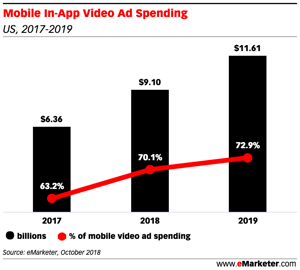Video advertising is primed to power significant growth for U.S. programmatic ad spend, wrote eMarketer in its latest ad spending forecast — and mobile is the driving force.
This year, for this first time, mobile devices will account for more than half (52.5%) of all programmatic video ad spend in the U.S., with 70.1% of all mobile video ad spend going in-app.
Video is the fastest-growing channel in programmatic advertising. Per eMarketer, video ad spend growth in the U.S. will rise 34% this year — more than display (30.5%) and mobile (32.5%). Video is no longer a fringe channel that marketers can experiment with: It’s the primary driver of programmatic growth.
The problem? Ad fraud hits mobile in-app video the hardest.
Mobile app video ad fraud is consistently above 20%
Pixalate collected global programmatic advertising data between May and August 2018 to measure invalid traffic (“IVT”) rates across devices and channels. Our data reveals that mobile in-app video — on both smartphones and tablets — is the riskiest environment for advertisers.
- Smartphone app video had the highest IVT rates in August and July, and third-highest in May and June
- Tablet app video ad the highest IVT rates in May and June and the 2nd-highest in July and August
- Mobile app video was the only category to be near or above 20% every month
Despite 20% ad fraud rates, marketers are pouring more money into mobile app video
Per eMarketer, mobile in-app video ad spend will rise 43.2% this year, up to $9.1 billion. It will rise another 28% next year, to $11.6 billion.
This is not surprising. After all, mobile in-app video is a convergence of three of the fastest-rising trends in advertising (mobile, app, and video). However, because mobile in-app video is where all things relatively new intersect, marketers are ill-prepared to meet the challenges.
Mobile in-app is inherently more difficult to measure compared to desktop, and video advertising is also challenging to properly measure. Some anti-ad-fraud industry initiatives — like ads.txt — don’t yet exist within mobile apps, putting the in-app environment even further behind the 8-ball when it comes to maintaining quality. (The industry is waiting on the app stores to support mobile in-app ads.txt, reported Digiday.)
It’s a recipe for ad fraud, and the fraudsters know this. It’s difficult to detect, which allows the fraudsters to fly under the radar for longer periods of time.
As RhythmOne’s Karim Rayes, SPV of products and business development recently said, "IVT for mobile apps acts a bit differently, because once it gets inside the app, it has a longer lifespan than mobile web."
See how mobile app video ad fraud can cost advertisers millions of dollars
Our MegaCast app discovery — one of the largest examples of mobile app ad fraud uncovered to date — showed that the alleged mobile app laundering relied on 40% video ads and 60% display ads. Even though there were fewer total invalid video ads than display ads, the video ads accounted for 84% of the lost money because video carries higher CPMs.
Fraudsters have a high financial incentive to exploit video ads for their own gain, and they will continue to do so unless marketers take the proper precautions.
Up next: How to reduce mobile app video ad fraud
Our data reveals that mobile in-app video ad fraud is the biggest problem for advertisers, and our next piece will show you what you can do about it.







